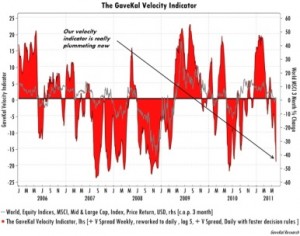Deflation
from John Mauldin’s letter
Deflation first…
Velocity Rolls Over
The following came to my inbox from my friends at GaveKal. They chart their own private calculation of the velocity of money. Notice in the chart below that the velocity of money was screaming “Problem!” during the recent crisis, began to improve with the recovery in 2009, rolled over with the end of QE1, and started to improve again (more or less) with QE2. Now, with QE2 ending, velocity is already down and falling, which is worrisome, as this comment shows. (Understand, the guys at GaveKal are typically looking for reasons to be bullish.)
“As we have highlighted in recent Dailies, our Velocity Indicator has been heading south rather rapidly. At first glance, this might appear surprising as there are few signs of stress in the financial system today: corporate spreads are decently tight, IPOs continue to roll out, and the VIX remains low. Sure, Greek debt has now been downgraded below Montenegro’s and stands at the same ratings as Cuba’s, but even acknowledging this, the recent depths reached by our Velocity Indicator is still somewhat surprising. Why, in the face of fairly benign markets, is our indicator so weak?
“The answer is very simple and it is linked to the recent underperformance of banks almost everywhere. Indeed, with short rates still low everywhere, and yield curves positively sloped, we are in the phase of the cycle when banks should be outperforming. The fact that they are not has to be seen as a concern. So does the underperformance come from the fact that the market senses that losses have yet to be booked (Europe?)? Is it a reflection of a lack of demand for loans (US?) or that more losses and write-offs are just around the corner (Japan?)? Is the bank underperformance signaling that we are on the verge of a new banking crisis, most likely linked to the possibility of European debt restructurings? Or perhaps it is linked to the coming end of QE2 and consequential tightening in the liquidity environment ?
“In our view, any of the above could potentially explain the recent bank underperformance. But whatever the reasons may be, it has to be seen as a worrying sign. One of our ‘rules of thumb’ is that if banks do not manage to outperform when yield curves are steep, the market must be worried about the financial sectors’ balance sheets (given that, with a steep yield curve, there are few reasons to worry about the bank’s income statement).”
